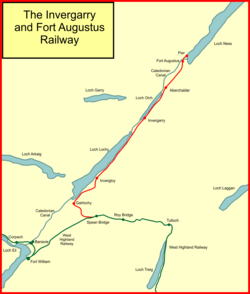Invergarry and Fort Augustus Railway

Map of Invergarry and Fort Augustus Railway
|
|

Remains of the station and yard at Fort Augustus, photographed in 1948
|
|
| Reporting mark | I&FAR |
|---|---|
| Dates of operation | 1903–1946 |
| Successor | North British Railway |
| Track gauge | 4 ft 8 1⁄2 in (1,435 mm) standard gauge |
| Length | Spean Bridge to Fort Augustus 23 miles 13 chains (37.3 km) 1903-1946 Fort Augustus to Fort Augustus Pier 73 chains (1.5 km) 1903-1906 |
The Invergarry and Fort Augustus Railway was a branch-line railway built in Scotland, connecting the named places with the main line at Spean Bridge. It opened in 1903.
Serving exceptionally sparsely inhabited areas it was never commercially successful, but it rekindled hostilities between larger railways over a planned railway connection along the Great Glen reaching Inverness; however this scheme never materialised.
Passenger train operation ceased in 1933 and the line closed completely in 1946.
The Great Glen is a natural rift valley that runs from diagonally across the Highlands of Scotland from Fort William on Loch Linnhe in the south west to Inverness on the Moray Firth in the north east.
It forms an easy communication route and as well as roads, the Caledonian Canal was constructed along it by linking natural lochs with canal sections. It opened to sea-going vessels in 1822 but the limited size of the canal sections proved inadequate for general merchant shipping.
In the railway age, Inverness was an important commercial centre, and from 1854 it was the focus of railway communication, and from a company amalgamation in 1865 the Highland Railway was dominant in that area. Agriculture and industry was active in the eastern side of the country and railway development there was more vigorous. By contrast the western side of the area was backward and depressed. The first railway to attempt to reach the west coast was the Dingwall and Skye Railway, authorised in 1865 to build from Dingwall, north of Inverness, to Kyle of Lochalsh, close to the Isle of Skye. In fact the line opened only as far as Stromeferry on Loch Carron, a more difficult anchorage than Kyle of Lochalsh, in 1870. (The Highland Railway later absorbed the Dingwall and Skye Railway, and in 1897 it extended the line to Kyle of Lochalsh.)
An approach to the west coast further south was attempted by the Callander and Oban Railway, by extending from an existing branch line from Dunblane at Callander. Oban was already an important hub of communication with the islands and coastal towns. The construction of this line was also difficult, passing through rocky landscapes with a thin population density. There were serious money problems, but with the considerable support of the Caledonian Railway Oban was at last connected to the railway system in 1880.
...
Wikipedia
